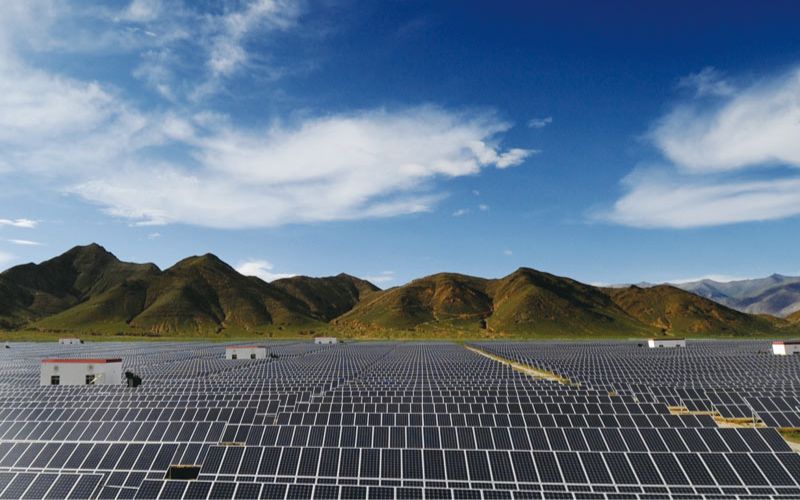
Recently, China has announced the commencement of construction on the world's largest photovoltaic (PV) power station project in Occupied Tibet. The project, located in Angduo Township, Mangkang County, Chamdo City, is part of the Jinsha River upstream clean energy base, a significant engineering project outlined in China's 14th Five-Year Plan, reported by China's official globaltimes.cn on 26 May 2023.
China's ambitious efforts to promote renewable energy, particularly solar and wind power for their potential to combat climate change and reduce greenhouse gas emissions. However, the expansion of these renewable energy sources in Tibet has raised concerns of environmental impacts on the region's fragile and unique ecosystem.
One of the primary concerns of renewable energy like solar is the land use and habitat loss associated with larger utility-scale solar facilities. The expansion of such facilities can lead to land degradation and habitat fragmentation, potentially affecting local wildlife and ecosystems.
“From 2015 to the end of 2020, 6.5 billion kwh of clean energy-generated electricity was transmitted (from Tibet), which greatly reduced carbon dioxide emissions,” says the White Paper ‘Tibet since 1951: Liberation, Development and Prosperity’ published in 2021, but, as pointed out here, it fails to acknowledge the reality that Tibet per se did not benefit. "The Tibet generated power is transmitted to Mainland China to its lighthouses and to run its machines even as large parts of Tibet go dark in the night", points out the author.
These developments have to be looked at with caution since occupied Tibet’s environment is exploited by CCP to meet its ends. Tibetan plateau is often known as the “Third Pole”, and holds the third-largest store of water ice in the world. Its glaciers feed several of the world’s largest rivers, rivers that over 1.5 billion people throughout south and southeast Asia depend on every day for their water supply. Yet Tibet is warming three times faster than the rest of the earth, losing an estimated eight billion tonnes of ice being lost every year as glaciers disappeared.
The purportedly “green” policy that China is pursuing in Tibet has been of building a number of dams on the plateau, to reduce the country’s dependence on coal. However, the cost of the CCP’s megaprojects is being paid by the local Tibetans, in the form of disruption of their habitats as well as dislocation of people. Lianghekou hydropower station, for instance, which is located in Ganzi Tibetan Autonomous Prefecture was estimated to help reduce raw coal consumption by 13.3 million tons and carbon dioxide emission by 21.3 million tons per year, the report said.
Beneath the veil of “green energy”, about 6,000 people across four counties were relocated and once it is fully completed by 2023, the Lianghekou dam will reportedly drown ancestral homes, Buddhist monasteries and sacred mountains.
China is also pursuing a policy of turning vast areas of Tibet into national parks, which is used as a pretext to remove even more Tibetans from their ancestral lands.
While the Chinese authorities claim that dams are green, and thus better for the environment than burning coal, China's dams, which it is building to divert water into its own territory, are targeted towards creating a “hydro hegemony” based on the control of the Tibetan plateau. Take for instance the case of Lianghekou hydropower station located in Ganzi Tibetan Autonomous Prefecture. It was estimated that the dam would help reduce raw coal consumption by 13.3 million tons and carbon dioxide emission by 21.3 million tons per year. But beneath this veil of “green energy”, about 6,000 people across four counties were relocated and once it is fully completed by 2023, the Lianghekou dam will reportedly drown ancestral homes, Buddhist monasteries and sacred mountains.
China's dominance of the lithium battery and electric vehicle industries is heavily reliant on lithium from Tibet. Lithium mines desecrate the sacred grasslands and spawn deadly pollution. China's thirst for the rich mineral resources of Tibet has put the lives of Tibetan nomads at stake. All this, to later claim that they are working towards lesser carbon monoxide emission and pollution.
An article published on Earth.com delves into the broader environmental impacts of renewable energy generation, including wind and solar. The report emphasizes the need for careful consideration of the potential consequences on local ecosystems and biodiversity. In Tibet, where the natural environment is known for its unique and delicate balance, such considerations are of paramount importance. The rapid expansion of solar and wind power projects in the region raises concerns about potential disruptions to wildlife habitats, migratory patterns, and overall ecosystem health.
Edited and collated by Team TRC